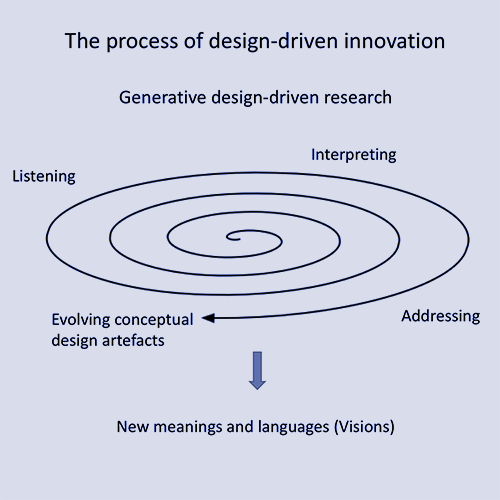Design-driven innovation in design practice
The case of designing a ship-bridge vision
DOI:
https://doi.org/10.7577/formakademisk.1856Abstract
The aim of this paper is to investigate Verganti’s framework for design-driven innovation (DDI) in the context of design practice and to discuss, elaborate and deepen the understanding of DDI, especially on aspects related to design. To meet this aim, an in-depth longitudinal case study of a DDI project for developing a radical new vision for an offshore ship bridge concept is performed. DDI is generally recognised as an in-depth research process, but we also approach it as a highly creative, generative process of design in which design artefacts serve as knowledge production and exploration. Therefore, Verganti’s divide between research and creativity and his critique of user centredness are challenged. The paper adds complementary understandings to Verganti’s framework, particularly regarding the role of design, and the Generative Design-Driven Innovation framework is developed.

Downloads
Published
How to Cite
Issue
Section
License
Authors who publish with this journal agree to the following terms:
- Authors retain copyright and grant the journal right of first publication with the work simultaneously licensed under a Creative Commons Attribution 4.0 License that allows others to share the work with an acknowledgement of the work's authorship and initial publication in this journal.
- Authors are able to enter into separate, additional contractual arrangements for the non-exclusive distribution of the journal's published version of the work (e.g., post it to an institutional repository or publish it in a book), with an acknowledgement of its initial publication in this journal.
- Authors are permitted and encouraged to post their work online (e.g., in institutional repositories or on their website) prior to and during the submission process, as it can lead to productive exchanges, as well as earlier and greater citation of published work (See The Effect of Open Access).
- The author(s) must manage their economic reproduction rights to any third party.
- The journal makes no financial or other compensation for submissions, unless a separate agreement regarding this matter has been made with the author(s).
- The journal is obliged to archive the manuscript (including metadata) in its originally published digital form for at least a suitable amount of time in which the manuscript can be accessed via a long-term archive for digital material, such as in the Norwegian universities’ institutional archives within the framework of the NORA partnership.
The material will be published OpenAccess with a Creative Commons 4.0 License which allows anyone to read, share and adapt the content, even commercially under the licence terms:
This work needs to be appropriately attributed/credited, a link must be provided to the CC-BY 4.0 licence, and changes made need to be indicated in a reasonable manner, but not in any way that suggests that the licensor endorses you or your use.



